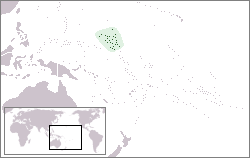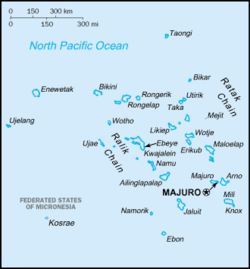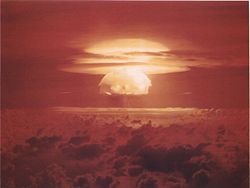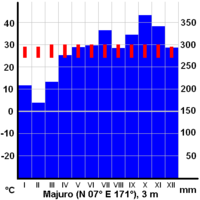Marshall Islands
2008/9 Schools Wikipedia Selection. Related subjects: Geography of Oceania (Australasia)
| Aolepān Aorōkin M̧ajeļ Republic of the Marshall Islands |
||||||
|---|---|---|---|---|---|---|
|
||||||
| Motto: "Jepilpilin ke ejukaan" ("Accomplishment through Joint Effort") | ||||||
| Anthem: Forever Marshall Islands |
||||||
|
|
||||||
| Capital (and largest city) |
Majuro |
|||||
| Official languages | Marshallese, English | |||||
| Demonym | Marshallese | |||||
| Government | Democratic Presidential Republic in Free Association with the USA | |||||
| - | President | Litokwa Tomeing | ||||
| Independence | ||||||
| - | from the United States | October 21, 1986 | ||||
| Area | ||||||
| - | Total | 181 km² ( 213th) 69.8 sq mi |
||||
| - | Water (%) | negligible | ||||
| Population | ||||||
| - | July 2005 estimate | 61,963 ( 205th) | ||||
| - | 2003 census | 56,429 | ||||
| - | Density | 326/km² ( 28th) 846/sq mi |
||||
| GDP ( PPP) | 2001 estimate | |||||
| - | Total | $115 million ( 220th) | ||||
| - | Per capita | $2,900 (2005 est.) ( 195th) | ||||
| HDI (n/a) | n/a (unranked) ( n/a) | |||||
| Currency | United States dollar ( USD) |
|||||
| Time zone | ( UTC+12) | |||||
| Internet TLD | .mh | |||||
| Calling code | +692 | |||||
The Marshall Islands, officially the Republic of the Marshall Islands (RMI), is a Micronesian island nation in the western Pacific Ocean, located north of Nauru and Kiribati, east of the Federated States of Micronesia and south of the U.S. territory of Wake Island, to which it lays claim.
History
Although the Marshall Islands were settled by Micronesians in the 2nd millennium BC, little is known of their early history. Spanish explorer Alonso de Salazar was the first European to see the islands in 1526, but they remained virtually unvisited by Europeans until the arrival of British Captain John Marshall in 1788; the islands are now named after him.
A German trading company settled on the islands in 1885, and they became part of the protectorate of German New Guinea some years later. Japan conquered the islands in World War I, and administered them as a League of Nations mandate.
In World War II, the United States invaded and occupied the islands (1944) destroying or isolating the Japanese garrisons, and they were added to the Trust Territory of the Pacific Islands (including several more island groups in the South Sea). From 1946 to 1958 the US tested 66 nuclear weapons in the Marshall Islands, including the largest nuclear test the US ever conducted, Castle Bravo. Nuclear claims between the US and the Marshall Islands are ongoing, and health effects from these tests linger. (See Rongelap.)
In 1979, the Government of the Marshall Islands was officially established and the country became self-governing. In 1986 the Compact of Free Association with the United States entered into force, granting the Republic of the Marshall Islands (RMI) its sovereignty. The Compact provided for aid and US defense of the islands in exchange for continued US military use of the missile testing range at Kwajalein Atoll. The independence was formally completed under international law in 1990, when the UN officially ended the Trusteeship status.
On March 21, 2007, the government of the Marshall Islands declared a state of emergency due to a prolonged drought.
Government
The government of the Marshall Islands operates under a mixed parliamentary-presidential system. Elections are held every four years in universal suffrage (for all citizens above 18 years of age) with each of the twenty-four constituencies (see below) electing one or more representatives (senators) to the lower house of RMI’s bicameral legislature, the Nitijela. ( Majuro, the capital atoll, elects five senators.) The President, who is head of state as well as head of government, is elected by the 33 senators of the Nitijela.
Legislative power lies with the Nitijela. The upper house of Parliament, called the Council of Iroij, is an advisory body comprising twelve tribal chiefs.
The executive branch consists of the President and the Presidential Cabinet (ten ministers appointed by the President with the approval of the Nitijela.)
The twenty-four electoral districts into which the country is divided correspond to the inhabited islands and atolls: There are currently three political parties in the Marshall Islands: AKA, UPP & UDP. The ruling party is combined of both the AKA and UPP.
- Ailinglaplap Atoll - Senator Christopher Loeak (AKA), Senator Ruben Zackhras (UDP)
- Ailuk Atoll - Senator Maynard Alfred (UDP)
- Arno Atoll - Senator Nidel Lorak (UPP), Senator Gerald M. Zackios (UDP)
- Aur Atoll - Senator Norman Matthew (UPP)
- Ebon Atoll - Senator John Silk (UDP)
- Enewetak Atoll - Senator Jack Ading (UPP)
- Jabat Island- Senator Kessai Note (UDP)
- Jaluit Atoll - Senator Rien R. Morris (UDP), Senator Alvin T. Jacklick (UDP)
- Kili Island - Senator Tomaki Juda (UDP)
- Kwajalein Atoll - Senator Michael Kabua (AKA), Senator Tony deBrum (AKA), Senator Jeban Riklon (AKA)
- Lae Atoll - Senator Rellong D. Lemari (AKA)
- Lib Island - Senator Jerakoj Jerry Bejang (AKA)
- Likiep Atoll - Senator Donald Capelle (UDP)
- Majuro Atoll - Senator Alik Alik (UDP), Senator Wilfred I. Kendall (UDP), Senator David Kramer (IND), Senator Brenson S. Wase (UDP), Senator Jurelang Zedkaia (AKA)
- Maloelap Atoll - Senator Michael Konelious (UDP)
- Mejit Island - Senator Dennis Momotaro (UPP)
- Mili Atoll - Senator Kejjo Bien (UPP)
- Namdrik Atoll - Senator Mattlan Zackhras (UDP)
- Namu Atoll - Senator Kaibuke Kabua (AKA)
- Rongelap Atoll - Senator Kenneth Kedi (IND)
- Ujae Atoll - Senator Fred Muller (UPP)
- Utirik (Utrik) Atoll - Senator Amenta Matthew (IND)
- Wotho Atoll - Senator David Kabua (AKA)
- Wotje Atoll - H.E. President Litokwa Tomeing (UPP)
Geography
The country consists of 29 atolls and 5 isolated islands. The most important atolls and islands form two groups: the Ratak Chain and the Ralik Chain (meaning "sunrise" and "sunset" chains). Two-thirds of the nation's population lives on Majuro (the capital) and Ebeye. The outer islands are sparsely populated due to lack of employment opportunities and economic development. Life on the outer atolls is generally still fairly traditional, and the nutrition of the rural population, consuming food that is either grown or caught, is superior to that of most of the urban residents, who rely considerably on white rice. A majority of the islands' land mass is at sea level.
The uninhabited atolls are:
|
|
The climate is hot and humid, with a wet season from May to November. The islands occasionally suffer from typhoons. Many Pacific typhoons start in the Marshall Islands region and grow stronger as they move west toward the Mariana Islands and the Philippines.
The Marshall Islands also lays claim to Wake Island, administered by the United States, under the name Enen-kio.
Economy
United States government assistance is the mainstay of the economy. Agricultural production is concentrated on small farms, and the most important commercial crops are coconuts, tomatoes, melons, and breadfruit. Small-scale industry is limited to handicrafts, fish processing, and copra. The tourist industry, now a small source of foreign exchange employing less than 10% of the labor force, remains the best hope for future added income. The islands have few natural resources, and imports far exceed exports.
In 1999, a private company built a tuna loining plant with more than 400 employees, mostly women. But the plant closed in 2005, after a failed attempt to convert it to produce tuna steaks, a process that requires half as many employees. Operating costs exceeded revenue, and the plant's owners tried to partner with the government to prevent closure. But government officials personally interested in an economic stake in the plant refused to help. After the plant closed, it was taken over by the government, which had been the guarantor of a $2 million loan to the business. The government effectively shut down the only viable industry to ever exist in the Marshall Islands.
In 2005 Aloha Airlines canceled its flight services to the Marshall Islands as part of its withdrawal from several markets in the region. Though other international airlines still serve Majuro, the Aloha decision was a setback in the country's hopes of increased revenues from tourism.
Under the terms of the Amended Compact of Free Association, the US will provide millions of dollars per year to the Marshall Islands (RMI) through 2023, at which time a trust fund made up of US and RMI contributions will begin perpetual annual payouts. Over the past decade, GDP growth averaged only 1% due to government downsizing, drought, a drop in construction, the decline in tourism and foreign investment due to Asian financial difficulties, and less income from the renewal of fishing vessel licenses.
The 2007 edition of "Doing Business," prepared by the World Bank's private sector development department, declared the Marshall Islands to be the world's "Best Performer" for its ease and low expense in hiring and firing employees. But the study gave the Marshall Islands extremely low ratings for its protection of investors and contract enforcement.
In 2007 the Marshall Islands joined the International Labor Organization, which means its labor laws will comply with international benchmarks, which will impact business conditions in the islands.
The United States Army maintains its Ronald Reagan Ballistic Missile Defense Test Site on Kwajalein Atoll. It is important for the local economy, as the Marshallese land owners receive rent for the base, and a large number of Marshallese work there. Majuro Atoll also benefited from foreign assistance. The main airport was built by the Japanese during World War II, and the only tarmac road of the capital was built partly by the Taiwanese and partly by the Americans.
Taxes are low, the income tax has 2 brackets with small rates (8% and 14%), corporate tax is 11.5% and general sales tax is 6%. There are no property taxes.
Coconut oil
On September 15, 2007, Witon Barry, of the Tobolar Copra processing plant in the Marshall Islands capital of Majuro said power authorities, private companies and entrepreneurs had been experimenting with coconut oil as alternative to diesel fuel for vehicles, power generators and ships. Coconut trees abound in the Pacific's tropical islands. Copra, from 6 to 10 coconuts makes 1 litre oil.
Demographics
The Marshallese are of Micronesian origin and migrated from Asia several thousand years ago. Although English is an official language and is spoken widely, though not fluently, Marshallese is used by the government. Japanese is also occasionally spoken in some areas.
Virtually all Marshallese are Christian, most of them Protestant.
The Marshall Islands has the highest rate of leprosy in the world.
Culture
Although now in decline, the Marshallese were once able navigators, using the stars and stick and shell charts. They are also experienced in canoe building and still hold annual competitions involving the unique oceanic sailing canoe, the proa.






